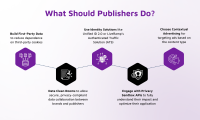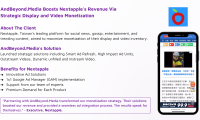10 In-app Advertisement Mistakes That Marketers Must Avoid
Mobile apps have gained tremendous popularity in the past few years. There has been a significant rise in the number of apps, app publishers, and in-app purchases in the last few years. Consequently, in-app advertising (IAA) became one of the prime marketing channels for marketers. Publishers or app owners are utilizing their space to generate a stream of mobile advertising that focuses on personalized experiences. This has highly influenced the dynamics of ad targeting and buying for marketers.
2022 has seen a steep rise in the number of apps downloaded in the Asia Pacific (APAC). Given the scope of innovation and young age demographics, Asia’s mobile market has always been a pool of opportunities for global marketers.
In 2022, the projected number of app downloads in Asia was 164,714.2 million. In-app advertising revenue is expected to show an annual growth rate (CAGR 2022-2026) of 9.46%, resulting in a projected market volume of US$372.30bn by 2026. The growth will be driven by the advent of AR game apps, mobile gaming, OTT, social video apps, and the mobile metaverse.
What are the key challenges faced by publishers in In-app advertisements?
- Getting lost in the herd
The above statistics are highly compelling and convincing that mobile apps and in-app advertisements are lucrative. But with the rising popularity of this platform comes the struggle to fight for user attention as well as retention.
- Evolving user dynamics
Consumer expectations are subject to factors like economic conditions, availability, convenience, and so much more. It can be difficult for app marketers and owners to align their campaigns and strategies with the fluctuating user demands.
- Privacy concerns
App data privacy has always been a matter of concern. Apps are efficient in providing meticulous data about user activity, but it has not always been received well by the users. A study analyzed around 2.2M reviews from the top 539 apps of this Android market. It concluded that 0.5% of these reviews were related to the security and privacy concerns of the users.
- Reliability of SDK monetization
Marketers are highly reliant on SDKs (Software Development Kit) to efficiently place apps without disrupting the user experience. Without that, they may miss out on user retention and in-app purchases (IAP).
- Standardized ad formats
In-app experiences are meant to be interactive and intuitive. However, it cannot be achieved with static ads including only images and texts. Digital ad formats are more advanced than that.
The potential of in-app advertisement is way more than what meets the eye. Even with such a wide scope for growth, marketers are failing to achieve the most of this ad media.
Here are some common mistakes committed by them that are stunting the results of In-app ads
- Treating mobile experience the same as desktop
App owners and marketers should know that accessing mobile apps is not equivalent to websites on desktops. They are not a minimized version of what users see on the desktop. Mobile apps are designed to deliver a more personalized and quicker experience. Mobile screens narrow down the user’s attention and naturally, they focus on what is important to them. App owners and marketers must prioritize this user behavior for their ad campaigns.
- Building a mobile application without a marketing plan
The mere presence of an app on an online store does not drive downloads or customer retention. App publishers need a marketing plan to spread awareness about the app, increase positive reviews, and ratings and generate conversions from it. It can be achieved through App Store Optimization. App publishers must also promote their apps through their presence on various channels like existing websites, email marketing, and social media platforms. The promotions must be backed by the right measurements and KPIs to derive adequate results.
- Treating mobile website as an application
A mobile website is a version of a desktop website designed to appropriately and coherently fit on the mobile screen. However, a mobile application is a completely different platform altogether. The ads displayed on your mobile website and app differ from each other on grounds like ad formats, sizes, and responsiveness.
- Not considering viewability
In-app advertisers often neglect the fact that they have to optimize the ad designs, formats, and sizes according to the screen size and app design. Marketers need to understand the customer journey on the app, identify the high-impression page positions, experiment with ad placements, and prioritize vertical ad units for optimum viewability and ad revenue.
- Neglecting user experience
Once the app publishers have successfully garnered a user base, they start prioritizing ads over user experience which often leads to ad stuffing or irrelevant ads. Just getting app downloads and not prioritizing customized user experience is a job half done that is as good as none. If your in-app ad placements are overwhelming or comprising the content on your app, then it may result in a decline of your user base over time.
- Not prioritizing the metrics
The steps to a successful app marketing campaign comprise user acquisition, driving engagement, retention, and monetization. This theoretical process can have practical implications only when app publishers and advertisers prioritize the right metrics and KPIs. App publishers should not ignore the results of their app activities or ads. All apps must focus on metrics like add to cart to conversion value, impressions, viewability, data collection, the number of times payment info was added, initiated checkouts, etc.
- Not including a strong call to action
In-app ads have the scope to drive higher conversion than websites. But it cannot be achieved without appropriate and appealing CTAs. With CTAs marketers can encourage users to take desirable actions like in-app purchases, downloading another app after viewing the ad, subscriptions, and submissions. Don’t leave the users clueless after they have seen an ad. Seal the deal with significant CTAs.
- Poorly designed User Interface
Mobile app designs and content influences the user experience and their decision-making. Inconsistent UI (User-interface) elements, not enough difference between primary and secondary buttons, lack of text hierarchy, and not using appropriate brand colors are some of the signs of a bad app design.
- Concentrating on only web and not In–App Ads
While web ads have their own perks, app owners and marketers must equally prioritize in-app ads. Mobile apps of different niches like gaming, entertainment, and social networking have a younger demographic and a substantial audience. In-app ads are highly trending and innovative. Marketers must focus on user activity on the apps and their motivation by staying in touch with them through other media channels. Apps are known to create personalized experiences. They must keep up with that ideology and serve contextual ads that are relevant and creative.
- Reformatting desktop ads
Different devices have different ad formats that perform well on them. Reformatting desktop ads to fit the mobile screen dimensions will bring no results. Marketers need to understand the difference in user behavior on website and app navigation. In-app ads have opened a new stream of ad formats and ad sizes for marketers. Some of the successful ones include rewarded video ads, interstitial ads, vertical video ads, mobile native ads, and app open ads.
Marketers need to understand that in-app advertisement is a new realm of marketing in itself. They should acknowledge and meticulously understand the ongoing mobile advancements, alter user behaviors, and respond to them by creating new targeting and advertising strategies. Using the web or desktop advertisement tactics on app advertisement will stunt the possibility of user acquisition and revenue growth. Keeping the website and desktop experience separate from the app experience is not a way for audience fragmentation. Instead, it is a strategic way of consolidation and creating wider ad revenue opportunities.




Leave a Reply